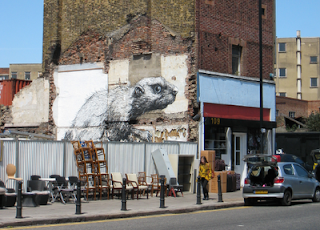
Tuesday, 31 May 2011
Hidden London: naked ladies in Twickenham

Monday, 30 May 2011
Friday, 27 May 2011
Soundtrack imaginaire
 Xavier Dolan's unrequited ménage à trois film Heartbeats (Les amours imaginaires), starring Monia Chokri, Niels Schneider and Dolan himself (pictured right to left), opens today. Artfully shot, if empty and irritating, it boasts probably the best (non-original) soundtrack I've ever heard, including Swedish band The Knife's steel drum electro runaround Pass This On, sibling offshoot Fever Ray's Keep the Streets Empty for Me and Bach's Cello Suite No 1 in G Major, BWV 1007. Highlights are outings for 3ième sexe by cult French '80s band Indochine, Isabelle Pierre's Le temps est bon and Dalida's Italian-language cover of Bang Bang, though unfortunately the last aren't available on iTunes in the UK.
Xavier Dolan's unrequited ménage à trois film Heartbeats (Les amours imaginaires), starring Monia Chokri, Niels Schneider and Dolan himself (pictured right to left), opens today. Artfully shot, if empty and irritating, it boasts probably the best (non-original) soundtrack I've ever heard, including Swedish band The Knife's steel drum electro runaround Pass This On, sibling offshoot Fever Ray's Keep the Streets Empty for Me and Bach's Cello Suite No 1 in G Major, BWV 1007. Highlights are outings for 3ième sexe by cult French '80s band Indochine, Isabelle Pierre's Le temps est bon and Dalida's Italian-language cover of Bang Bang, though unfortunately the last aren't available on iTunes in the UK.
Thursday, 26 May 2011
Street art week: Stik stuff





Wednesday, 25 May 2011
Street art week: found paintings
 Street art should be left where people see it but occasionally works are left out deliberately with the intention that they be collected. A friend dismissed some pieces by Adam Neate only to discover she could have picked up something of value for nothing - he was giving them away.
Street art should be left where people see it but occasionally works are left out deliberately with the intention that they be collected. A friend dismissed some pieces by Adam Neate only to discover she could have picked up something of value for nothing - he was giving them away. Tuesday, 24 May 2011
Monday, 23 May 2011
Street art week: wall memorials


Friday, 20 May 2011
Dark Times in Hackney
Daniel Kramb gave a reading of his first novel, Dark Times, at the lovely Sutton House Book Brunchers yesterday. Set against the backdrop of the financial crisis, the book is steeped in Hackney's streets, bars and clubs. Here's an interview we did earlier this year:
What was the inspiration for the book? When I started writing Dark Times, back in 2007, I set out to tell a story about four East Londoners. Getting into these people was a way for me to make sense of my own confusion, my place in the world. Then, in 2008, “the crisis” hit. Suddenly, everything seemed to collapse but at the same time there was, I thought, a great chance in front of our eyes. I wanted to capture that particular moment in time, and I wanted to tell the whole thing in a very intense, distinct style, which I had played around with for some time.
Dark Times has a very specific sense of place - how important is that to you? Very important. The book has four characters but the most important one might well be its fifth, and that’s East London, or Hackney, more specifically. It’s the one aspect of the book that was never in question, I wanted to write a love letter to this part of the city.
At one point in the book, you say, 'If you walked a street often enough, it became part of you'. How are your characters formed by their environment? That’s Sarah, the journalist in the book, and at that point she has started to walk up and down Stoke Newington High Street, something I used to do a lot. Whether we consciously feel it or not, I think we are formed - or at least greatly influenced - by our surroundings. It’s definitely true for the book’s characters: the idealistic Max, who is also a keen walker, is fed, if you like, by Clapton street life, and the park benches of Hackney Downs reinforce his constant state of waiting; Jonathan simply couldn’t function without the bars of Shoreditch and Dalston; for the struggling artist Lizzie, Ridley Road Market is both a source of great inspiration, and a constant reminder of her unstable, precarious life. But I think this is always a two-way process, a dialogue, between people and place.
You wrote a first draft of Dark Times when you lived in Hackney and then rewrote it when living abroad, in Amsterdam. How did that affect what you wrote? I think it helped: being taken out of your usual surroundings is always a kick-start for fresh thinking, so that was good for the rewriting process. More importantly, I started being terribly homesick for Hackney - it wasn’t about Amsterdam, I liked being there - but I had all these flashes of streets, sounds and smells hitting me out of nowhere. So I found myself sitting in a tiny attic overlooking the river Amstel, early in the morning, conjuring up the dirt of Dalston Lane, the coffee smell inside Café Oto, or the busy Shacklewell Lane junction seen from behind a late-night Turkish soup at Somine.
Dark Times is available on Amazon and at various bookstores (details in the first link on this post).
Wednesday, 18 May 2011
London on film: five great musicals

Tuesday, 17 May 2011
Wartorn London (and elsewhere) on film

Monday, 16 May 2011
Schlock city: The Curious Dr Humpp (1969)

Thursday, 12 May 2011
London on film: the blank canvas


Tuesday, 10 May 2011
Killing jokes

Monday, 9 May 2011
Three underrated boy bands

Thursday, 5 May 2011
Le grand Gérard




















